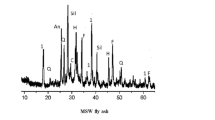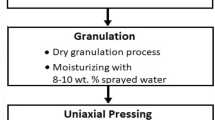Abstract
The objects of this study were to use waste foundry sand (WFS) to manufacture reclaimed resource tiles and to determine the effects of different kiln temperatures on the properties of the reclaimed WFS tiles. In this study, clay was replaced with 0 or 15 % WFS to manufacture tile specimens. Four different kiln temperatures (1000, 1050, 1100, and 1150 °C) were used in this study for the manufacture of tile specimens. The test results showed that using 15 % WFS in the tile specimens allowed the kiln temperature to be lowered by 50 °C. This temperature reduction is helpful for reducing costs and energy consumption and carbon reduction. Moreover, when the kiln temperature increased from 1000 to 1100 °C and the specimens were placed in acidic and alkaline solutions, the weight loss of the tile specimens containing 15 % WFS was half that of the specimens containing 0 % WFS. The acid-alkali resistance of the tile specimens containing 15 % WFS was also improved. This result suggested that the WFS replacement and kiln temperature affected the properties of the tile specimens.










Similar content being viewed by others
References
Bribián IZ, Capilla AV, Alfonso Usón AA (2011) Life cycle assessment of building materials: comparative analysis of energy and environmental impacts and evaluation of the eco-efficiency improvement potential. Build Environ 46:1133–1140
Reijnders L (2007) Cleaner phosphogypsum, coal combustion ashes and waste incineration ashes for application in building materials: a review. Build Environ 42:1036–1042
Alonso-Santurde R, Coz A, Viguri JR, Andrés A (2012) Recycling of foundry by-products in the ceramic industry: green and core sand in clay bricks. Constr Build Mater 27:97–106
Quijorna N, Coz A, Andres A, Cheeseman C (2012) Recycling of Waelz slag and waste foundry sand in red clay bricks. Resour Conserv Recycl 65:1–10
Zhang L (2013) Production of bricks from waste materials—a review. Constr Build Mater 47:643–655
Montero MA, Jordán MM, Almendro-Candel MB, Sanfeliu T, Hernández-Crespo MS (2009) The use of a calcium carbonate residue from the stone industry in manufacturing of ceramic tile bodies. Appl Clay Sci 43(2):186–189
Montero MA, Jordán MM, Hernández-Crespo MS, Sanfeliu T (2009) The use of sewage sludge and marble residues in the manufacture of ceramic tile bodies. Appl Clay Sci 46(4):404–408
Chen L, Lin DF (2009) Applications of sewage sludge ash and nano-SiO2 to manufacture tile as construction material. Constr Build Mater 23(11):3312–3320
Maschio S, Furlani E, Tonello G, Faraone N, Aneggi E, Minichelli D, Fedrizzi L, Bachiorrini A, Bruckner S (2009) Fast firing of tiles containing paper mill sludge, glass cullet and clay. Waste Manag 29(11):2880–2885
Torres P, Fernandes HR, Olhero S, Ferreira JMF (2009) Incorporation of wastes from granite rock cutting and polishing industries to produce roof tiles. J Eur Ceram Soc 29(1):23–30
Chiang KY, Chou PH, Hua CR, Chien KL, Cheeseman C (2009) Lightweight bricks manufactured from water treatment sludge and rice husks. J Hazard Mater 171(1–3):76–82
Al-Zboon KMT, Abu-Hamatteh ZSH, Al-Harahsheh MS (2010) Recycling of stone cutting sludge in formulations of bricks and terrazzo tiles. Waste Manag Res 28(6):568–574
Andreola F, Barbieri L, Bondioli F, Lancellotti I, Miselli P, Ferrari AM (2010) Recycling of screen glass into new traditional ceramic materials. Int J Appl Ceram Technol 7(6):909–917
Lin KL, Luo HL (2009) Evaluation of sintering characteristics of pavement tiles incorporation waste catalyst. Int J Pavement Res Technol 2(2):68–74
Lin KL, Huang LS, Shie JL, Cheng CJ, Lee CH, Chang TC (2013) Elucidating the effects of solar panel waste glass substitution on the physical and mechanical characteristics of clay bricks. Environ Technol 34(1):15–24
Sariisik A, Sariisik G, Sentürk A (2011) Applications of glaze and decor on dimensioned andesites used in construction sector. Construct Build Mater 25(9):3694–3702
Luo HL, Lin DF, Chung ML, Chen LY (2015) Waste foundry sand reused as clay replacement for tile manufacture. Int J Transport Sci Technol 3(4):339–352
Bellotto M, Gualtieri A, Artioli G, Clark SM (1995) Kinetic study of the kaolinite-mullite reaction sequence. Part I: kaolinite dehydroxylation. Phys Chem Minerals 22(4):207–214
Acknowledgments
This study was partly supported by the National Science Council of Republic of China (Grant No. NSC 101-2221-E-214 -063 -MY3-1).
Author information
Authors and Affiliations
Corresponding author
Rights and permissions
About this article
Cite this article
Lin, DF., Luo, HL., Lin, JD. et al. Characterizations of temperature effects on sintered ceramics manufactured with waste foundry sand and clay. J Mater Cycles Waste Manag 20, 127–136 (2018). https://doi.org/10.1007/s10163-016-0553-5
Received:
Accepted:
Published:
Issue Date:
DOI: https://doi.org/10.1007/s10163-016-0553-5




